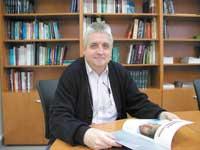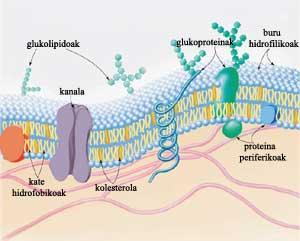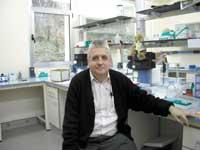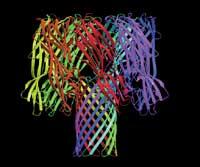Felix Goñi, a man in love with the membranes

Born in San Sebastián, he began studying medicine at the University of Navarra. “When I came to school, like almost everyone else, I didn’t know what medicine was. The case is that the first year Macarulla gave me biochemistry classes and impacted me so much that you decided then that I wanted to be biochemistry.” It was the course 1968-69. He subsequently joined the Biochemistry Department as an internal student and carried out his thesis with Esteban Santiago. “By then the subject was the one that touched me all my life, my thesis on the lipids of the mitochondrial membrane”.
In 1975 he read his thesis at the University of Navarra and the following year he moved to the laboratory of Dennis Chapman, in London. “Dennis Chapman was one of the top three in the world in membrane research and my scientific father immediately became a friend and advisor.” After two years of experience at the University of the Basque Country, he took the place of assistant professor of Biochemistry. In 1984 he was appointed professor in Santander, but soon returned. In 1986 he obtained the status of Professor of the UPV/EHU and since then has always been present, except in 1991 and 1999, which was in London and Canada during a season. In 1995 and 1999 he worked as director of scientific policy in the Basque Government, “but I didn’t think that’s why I left the laboratory.”
Working group, base and pillars
Macarulla, first year professor, came to the UPV-EHU and joined it in 1979. “It was very generous. In addition, he has been the perfect boss, allowed me to do what I wanted and has always protected me.”
Félix Goñi began working with membranes and detergents, along with Iñaki Guturbay. Félix has explained that detergents are a very important tool for the elimination of proteins from membranes, as well as for the introduction of proteins in dissolution. “We have always worked with the detergents, sometimes we have started with more desire and sometimes with less, but there has always been that line.”

Shortly afterwards, Alicia Alonso, who currently has a wife, began to carry out her thesis and dedicated herself to another important line of research. In fact, the mechanism of fusion and fusion of membranes began to be analyzed. The jury of the Euskadi Research Awards highlighted this work, among others.
At the same time, José Luis R. Arrondo met the group and investigated the structure of proteins through infrared spectroscopy. “We were one of the first in the world to apply this technology to proteins.”
According to Felix Goñi, among the four the research of Biochemistry was promoted and is now working. Since then more people have been added and as the group grows, the lines of research have been branched.
For example, Arturo Muga, Adelina Prado and Mª Angeles Urbaneja have formed a subgroup in which works less related to membranes are developed. It is being investigated how proteins double, which are the ones that help to double the proteins. “And soon this topic will be re-related to the words.”
Juan Mª Glez. Mañas, for his part, started working with the membranes and is now working with the toxins that have the objective in the membranes. From his point of view, it is curious that he is able to penetrate into the membrane toxins that are hydrosoluble proteins.

Helena Ostolaza also investigates how bacterial toxins penetrate the membrane. “Helena identifies a receptor for a toxin and discovers how to block it. The toxin, called hemolisine, is caused by the bacterium Escherichia coli and causes urinary tract infections. Thanks to a peptide discovered by Helena, the cells are protected from infection. As research has application, we have patented it.”
The first fusion model by an enzyme was also made. According to Felix Goñi, the merger research received a huge boost thanks to Txelu Nieva. The fusion model by Fosfolipasa C has generated numerous theses and publications. Subsequently, we began to analyze how viruses with membrane, such as AIDS and flu, and cells fuse. Specifically, it is investigating the proteins or peptides of viruses that cause the fusion of membranes.
The last members of the working group were Ana Rosa Vigera, of the Spanish Higher Council of Scientific Research (CSIC), and Itziar Alkorta and Gorka Basañez. Ana Rosa, first official from the CSIC, works with the folding of proteins, the conjugation of the Itziar bacteria, and Gorka mainly investigates the transformations of membranes in apoptosis.
Although each one has its responsibilities, Felix Goñi explains that everyone works together and that research is crossed. He has recognized that his team is also a group of friends, to whom he owes partly success.
Biophysics Unit

It is a dream realized by the Biophysics Unit for Felix Goñi. He is considered optimistic, “but in 1975, when I first came here without finishing the thesis, I couldn’t imagine that someday we had something like that.”
Having said this, he has always struggled to have a place of research and adequate means. Due to the close relationship between the University of Navarra and the CSIC, the mixed centers were very normal for it. But in those times the CSIC was in very bad condition and nothing could be achieved.
However, “I have always considered that the existence of a structure to promote research and research is necessary at the university. That is why I tried to get it eleven times.” And when I had the hope practically lost, the opportunity arose to collaborate with the CSIC. After several steps, in 1999 the Biophysics Unit was launched, which last year opened the new building.
The work in collaboration with the CSIC carries a series of benefits, especially for its greater space and resources, and for its participation in the network of high-level researchers, facilitates communication and relations.
Asked about his future expectations, he responded quickly and concisely: “work more and better”.
Buletina
Bidali zure helbide elektronikoa eta jaso asteroko buletina zure sarrera-ontzian











